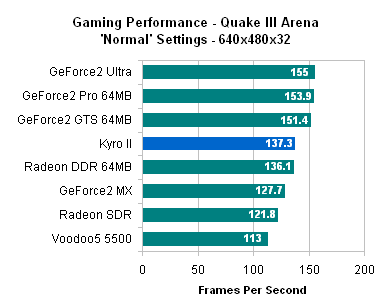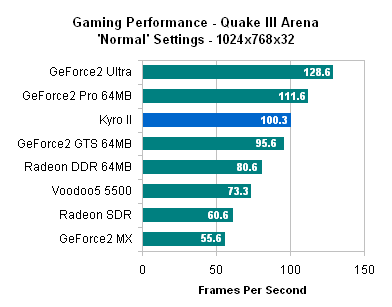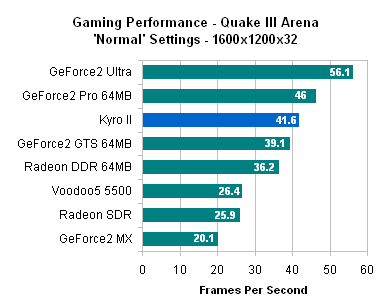Quake III Arena Performance

At 640x480x32 we see two aspects of a card, for the most part. First off is how well the drivers are performing. Historically poor drivers have led to poor performance at low resolutions. Also many times blamed for poor performance at low resolutions is the lack of a T&L engine.
In the case of the Kyro II, the drivers do not seem to be holding the card back. In addition, the card does not seem to flinch any when put up against T&L enabled cards such as the ATI Radeon DDR and the GeForce2 MX. The Kyro II performs very strong for a first showing. Could the drivers and lack of T&L still be holding the card back, even with its very strong 640x480x32 performance? Lets see what other resolutions show.

Indeed, if you thought the Kyro II's performance was impressive before, you are in for a shock with the 1024x768x32 performance. Not stressing a nonexistent T&L engine and not held back at all by early drivers, the Kyro II is able to actually outperform the popular (and more expensive) NVIDIA GeForce2 GTS by a noticeable amount.
Scoring slightly over 100 FPS in Quake III Arena, the Kyro II beats the GeForce 2 GTS by 5%. It also beats the comparatively priced GeForce2 MX by 80% and the Radeon DDR by 24%. The performance of the card, even this early on into the testing, was enough to do more than just catch our eye. We were frankly shocked when we saw that the Kyro II based Hercules/Guillemot 3D Prophet 4500 performed better than the 64MB GeForce2 GTS and is priced almost $90 less. In fact, the Kyro II came within 11% of the powerful NVIDIA GeForce2 Pro.

Not much changes as the resolution increases in Quake III Arena. At 1600x1200x32, the Kyro II holds its position right between the GeForce2 GTS and the GeForce2 Pro. Running only 11% slower than the GeForce2 Pro, the Kyro II looks like it is primed to take low cost video cards to a new level. If the Kyro II's Quake III Arena performance is any indication of the potential of tile based rendering, immediate mode renderers should run for the hills.










4 Comments
View All Comments
MonkeyPaw - Monday, February 24, 2014 - link
Thanks for the stroll down memory lane (by keeping the article up). I had one of these cards back in 2002, and it was one I looked back upon fondly. I can't remember most of the GPUs I owned from yesteryear, save the Voodoo 3 and the crappy S3 Verge. That's fairly elite company, at least in my brain, anyway. :)xrror - Monday, March 2, 2015 - link
Yea, it's sad that there wasn't any further development of the Kyro series in the PC market. If I remember right (probably needs fact checked) Imagination's development resources got sucked into the Sega Dreamcast after this point. Even that wouldn't have been so bad if Sega hadn't just given up on the Dreamcast so early on due to a "poor showing in Japan" (nevermind everyone loved it in the US but we didn't count apparently, also see Genesis/MegaDrive).I think Imagination or at least their tech lives on in the embedded/mobile space now, but meh - really wanted to see what they could have done with their tech without being shackled to a power budget in 2002-2005 era PC's.
Alexvrb - Wednesday, October 14, 2020 - link
You're wrong. The Dreamcast was designed years earlier using PowerVR Series 2. The later "Kyro series" was based on Series 3. The DC design win netted them some much needed cash which they used to fuel their Series 3 releases. What killed imgtech was their inability to play well with others (board partners) and issues staying on schedule for releases. If they had managed to get the 4800 out the door sooner, and released the larger Kyro III with DDR it would have bought them some time. Especially if they had paired it with a hardware T&L block like Elan.thegreatjombi - Wednesday, August 12, 2015 - link
Its very interesting to think that Imagination Technologies could have been another foot note in history (3dfx, bitboys Oy! Rendition..) but going mobile and refining their technology has allowed them to basically become more popular than ATI(AMD) or Nvidia. There are probably more devices in peoples houses running a powervr variant than have an AMD or Nvidia GPU.I do wish someone would stick their chip on a discrete card again, they apparently support full Directx and OpenGL! could be an interesting low profile, low end, low power, fanless card for HTPCs.